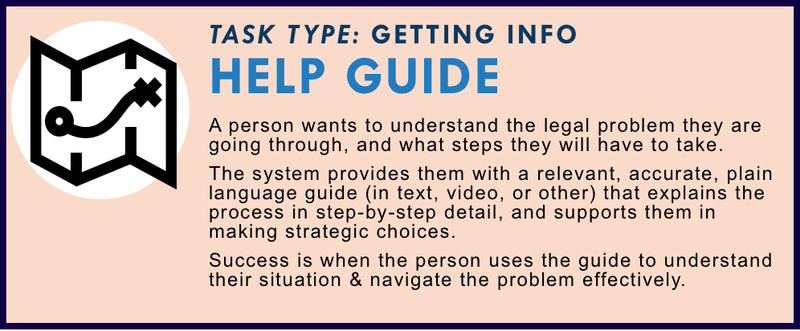Help Guide

Help people understand and navigate their legal problem with accurate, plain-language guides that explain the process step by step.
Task Description
When someone is facing a legal problem—like an eviction, custody dispute, benefits denial, or debt lawsuit—they often don’t understand what’s happening, what options they have, or what the process will look like. The legal system can be opaque and intimidating, especially for those without legal representation or formal education.
This task focuses on a system that acts as a legal process explainer and navigation guide generator. Based on the user’s legal issue, jurisdiction, and case stage, the system provides a relevant, plain-language guide in the format that best suits the user: written steps, visual diagrams, annotated forms, short videos, or audio walkthroughs. The content not only explains the process, but also supports decision-making by describing trade-offs, deadlines, and key strategic points.
The system may customize guidance based on user preferences or circumstances (e.g., “You said you need to respond to a court summons, and you’re in California—here’s what to do next”), and may offer different tracks for different case postures (e.g., contested vs. uncontested). It can offer printable versions, mobile-friendly formats, and layered content for different reading levels or accessibility needs.
This task is especially valuable for legal help websites, court self-help portals, public kiosks, and community justice navigators. It empowers people to move through complex systems with clarity—reducing drop-off, fear, and costly mistakes.
Success means the user understands what’s going on, what’s expected of them, and what steps to take—so they can engage more confidently and effectively with the legal system
How to Measure Quality?
📚 Accuracy and Relevance
- Guide content reflects the correct legal process for the user's issue and jurisdiction
- Clearly identifies what step the person is on and what comes next
- Flags key deadlines, requirements, and consequences of inaction
✍️ Plain Language and Clarity
- Uses clear, everyday language with minimal legal jargon
- Defines technical terms and gives examples where appropriate
- Supports different literacy levels and language preferences
🧭 Step-by-Step Navigation
- Breaks down the process into manageable, sequential steps
- Includes specific actions, timelines, and linked resources (e.g., forms, contacts, tools)
- Visual or interactive formats available for complex processes
🤝 Strategic Support
- Describes options, risks, and common outcomes at key decision points
- Helps the user weigh different paths (e.g., negotiate vs. file a motion)
- Encourages people to get legal advice when the issue is high-stakes or complex
📱 Multiformat and Accessibility
- Available in text, video, audio, and printable formats
- Mobile-friendly and screen-reader compatible
- Supports multilingual and disability-accessible versions
📈 Effectiveness and Outcomes
- Users report increased confidence and understanding after using the guide
- Follow-up tracking shows higher completion of key legal steps (e.g., filing, showing up to court)
- Supports lower rates of dismissal for procedural errors